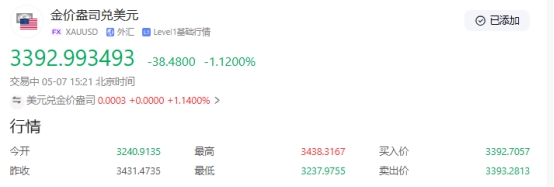The U.S. military and the Houthis reached a ceasefire agreement, and Trump's announcement of "epic news" disturbed the gold market
- 2025年5月9日
- Posted by: Macro Global Markets
- Category: News


On May 6, local time, US President Trump announced that the United States had reached a ceasefire agreement with the Houthi armed forces in Yemen, and would stop air strikes on the Houthi armed forces from that day on. The decision came after the Houthis promised to stop attacking U.S. ships in the Red Sea and the Bab el-Mandeb Strait in exchange for the U.S. military ending its seven-week bombing campaign that cost more than $1 billion. However, the Houthis have made it clear that they will continue their military operations against Israel until the blockade of the Gaza Strip is lifted.
At the same time, Trump hinted during a meeting with the Canadian Prime Minister on May 6 that "the most important news in history" would be announced "in a few days," but did not disclose the specific content. The market speculated that this "mysterious preview" might involve major diplomatic breakthroughs, domestic policy adjustments or economic stimulus plans, attracting great attention from global investors.
II. Turning Point in the Middle East Situation: The Front and Backstage of the Ceasefire Agreement
The core motivation for reaching the agreement
The Houthis have attacked Red Sea shipping with drones and missiles, forcing the United States to weigh military pressure against economic costs. During the seven weeks of air strikes, the Houthis shot down at least seven US drones, showing their tenacious resilience.
As a mediator, Oman facilitated an agreement between the two sides aimed at maintaining the security of the Red Sea shipping lanes and paving the way for subsequent Iran nuclear negotiations. The United States and Iran have held three rounds of nuclear negotiations, and a ceasefire may create conditions for a fourth round of negotiations.
Limitations and risks of the agreement
The Houthis only promised to stop attacking US ships, and the attacks on Israeli and related ships will continue. Israel was unaware of the agreement and the prime minister's office said it would "reserve the right to self-defense."
On May 6, local time in Yemen, Israel launched an air strike on Sana'a International Airport and other targets, killing three people. The Houthi armed forces vowed "devastating revenge", and the ceasefire agreement faced a test.
3. Gold market volatility: ceasefire and cooling and notice game
Short-term volatility: risk aversion recedes
In the early Asian session on May 7, spot gold plunged $50 from the overnight high of $3,434.74 an ounce to a low of $3,377, a drop of 1.5%. The trading volume of the main COMEX gold futures contract surged by 200%, indicating that the divergence between bulls and bears has intensified. Technically, gold prices fell below the 5-day moving average ($3,395), but still held the 20-day moving average ($3,360), with short-term support moving down to $3,350.

Federal Reserve policy: Market expectations for rate cuts this year have increased (97.2% probability). If Powell sends a dovish signal at the May FOMC meeting, it may weaken the dollar and support gold prices; Central bank gold purchases: Data from the World Gold Council shows that global central banks' net gold purchases reached 220 tons in the first quarter of 2025. China and India continued to increase their holdings, providing structural support for gold prices; Inflation pressure: The U.S. CPI in April was 3.0% year-on-year. If the data exceeds expectations, it may strengthen the demand for gold to fight inflation.
The current gold market is at a critical juncture where easing geopolitical risks and policy uncertainties are intertwined. The US military ceasefire will weaken safe-haven demand in the short term, but Trump’s “mysterious preview” and the Federal Reserve’s policy expectations still provide potential support for gold prices. Investors need to maintain flexible strategies, adjust their positions based on real-time events, and avoid chasing rising and falling prices.
